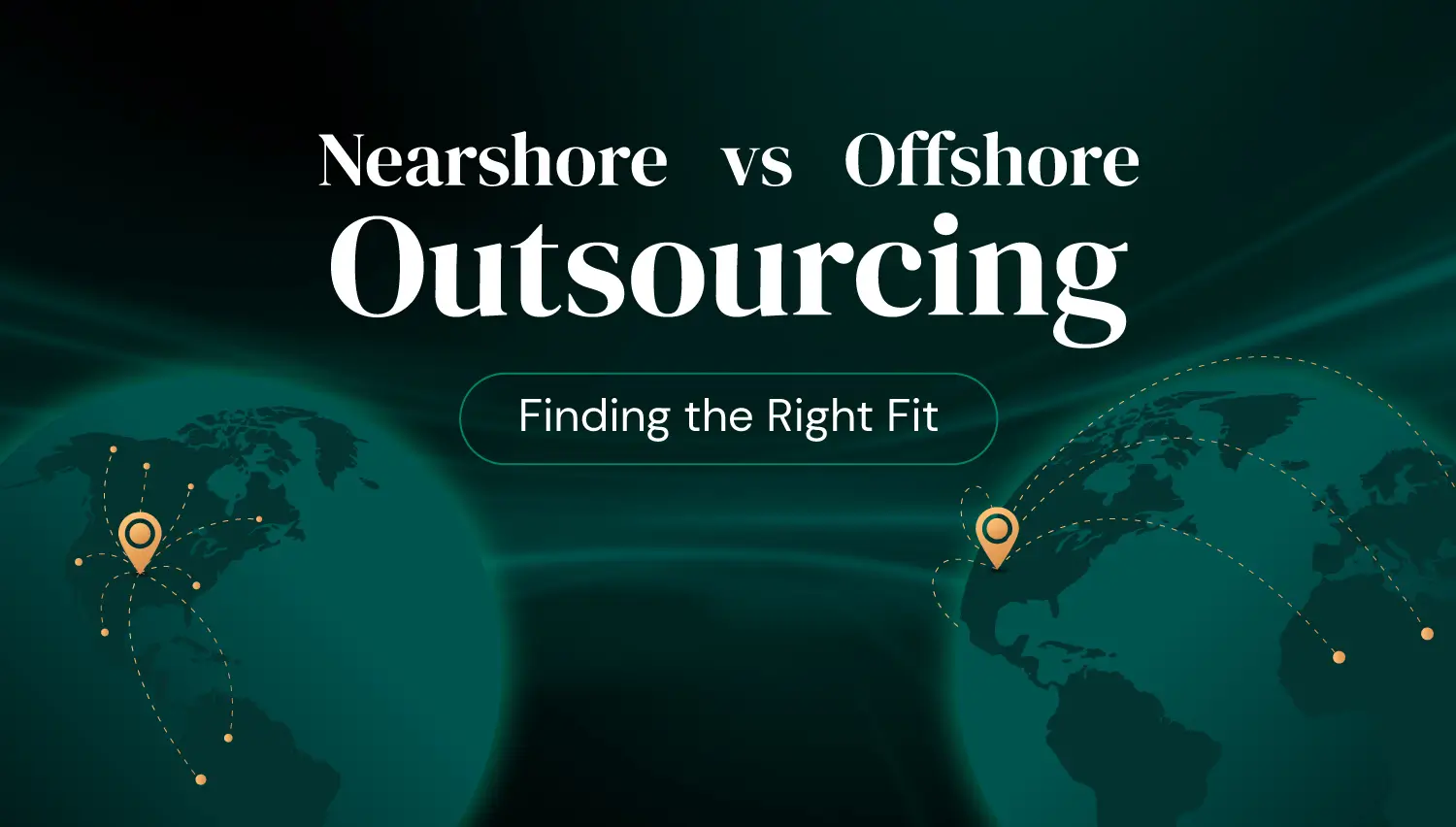One question I hear all the time from founders, COOs, and hiring managers is this: Should we go nearshore or offshore with our employee outsourcing? Over the past decade, I’ve seen both approaches succeed brilliantly and crash spectacularly.
A few years ago, a tech startup I was advising chose offshore developers, drawn by the lower costs and deep talent pool. Six months in, they were stuck with delayed sprints, misaligned requirements, and an exhausted internal team pulling late-night standups just to stay on track.
But nearshore partnerships aren’t immune to problems either. I’ve watched some stumble because of limited talent in niche skill areas or unexpectedly high costs that blew up budgets.
That’s why there’s no blanket answer here. The real question is fit: how well does each model mesh with your company’s way of working, your timelines, and your tolerance for complexity?
In this article, I’ll break down how nearshore and offshore outsourcing truly compare, why the distinction matters, and how to choose the route that fits your business.
Nearshore vs. Offshore: A Quick Look
At a high level, both nearshore and offshore outsourcing mean hiring skilled people outside your local market. But they differ in crucial ways, geography, cost, and how easy it is to collaborate.
Nearshore outsourcing involves working with teams in neighboring or nearby countries, usually one to three time zones away. For U.S. companies, that often means Latin America; for Western European businesses, it could be Eastern Europe. Proximity helps with real-time communication, and cultural similarities can smooth out collaboration.
Offshore outsourcing means working with teams much farther away, often eight to twelve time zones apart. India, Vietnam, and the Philippines are popular offshore hubs. The big draw is lower costs, thanks to wage differences. But the flipside is that time zone gaps and cultural differences can cause headaches in coordination and speed.
Neither model is automatically better. Each comes with trade-offs, depending on what kind of work you’re doing and how your organization operates.
Why Your Outsourcing Choice Matters
Outsourcing is more than a line item on a budget. It shapes how quickly you ship products, how well your teams collaborate, and how exposed you are if things go sideways.
I’ve seen companies save millions by going offshore, only to lose it all (and then some) in delays, rework, or misunderstandings that pushed roadmaps months off schedule. I’ve also seen nearshore deals fall apart when higher hourly rates or shallow talent pools blindsided businesses.
Your choice affects:
- How quickly you can deliver new products
- How smoothly your internal and external teams work together
- Hidden costs tied to time zones, travel, and project management
- Regulatory and compliance risks, especially in certain industries
Understanding these impacts isn’t optional; it’s critical before you commit to either model.

How to Decide Between Nearshore and Offshore
Whenever someone asks me how to choose, I tell them it’s like picking the right tool for a job. Neither nearshore nor offshore is automatically “better.” It’s all about the problem you’re trying to solve.
Here’s how I help clients think through the decision, based on what I’ve seen play out in the real world.
1. What Type of Work Are You Outsourcing?
The first question is always: What exactly are you outsourcing?
- Well-defined, repeatable tasks like data annotation, QA testing, or routine dev sprints often work well offshore. The processes are documented, handoffs are clear, and minimal real-time input is needed.
- Ambiguous, collaborative, or evolving projects like designing a new product, iterating on UI/UX, or handling sensitive customer service usually demand fast feedback, cultural understanding, and real-time problem-solving. That’s where nearshore can shine.
If your work hinges on quick pivots and live brainstorming, proximity may matter far more than a lower hourly rate.
2. How Much Latency Can You Handle?
Time zones can either help or hurt you.
- Offshore’s staggered hours are great for “follow-the-sun” development, where work hands off seamlessly across time zones.
- Nearshore keeps overlapping business hours, enabling same-day responses, impromptu calls, and shared standups.
A team launching a customer-facing product with daily releases probably can’t survive 12-hour lags. But a team working on backend infrastructure might thrive with offshore overnight builds.
My advice: audit your typical decision-making cycle. Are blockers resolved in hours or days? That’s your clue for how much time difference you can handle.
3. How Critical Is Cultural Understanding?
People often underestimate how much business culture, humor, and regional knowledge matter.
- Nearshore teams usually share closer cultural references and business norms with Western companies, easing collaboration on creative work, marketing, or product design.
- Offshore teams might be technically stellar but may need more guidance around subtler points like tone, user expectations, or regulatory context.
Neither group is incapable. The question is how much nuance your work demands to avoid costly misalignment.
4. What’s the Talent Market Like in Your Niche?
Sweeping statements like “offshore is cheaper” or “nearshore communicates better” miss one crucial point: specialization.
- Offshore regions often boast huge pools of developers, QA testers, and data scientists, perfect if you’re scaling fast or need dozens of specialists quickly.
- Nearshore markets can be smaller but may produce teams experienced with U.S. or European agile practices and regulatory standards.
For instance, if you’re tackling specialized fintech compliance work, a smaller but highly skilled nearshore team might be worth the higher cost.
My advice: look at talent depth in your niche, not just hourly rates.
5. How Much Management Overhead Can You Handle?
Offshore deals often demand more discipline: thorough documentation, robust ticketing systems, and structured communication. That’s not a flaw; it’s just the reality of working across distance and time.
Nearshore partners often blend into your workflows more smoothly, with fewer formalities and easier real-time collaboration.
If your internal team is already stretched thin, the management load of an offshore setup might be unsustainable, even if the rates look tempting.
Aligning Your Outsourcing Choice with Business Goals
Here’s the step too many companies skip: aligning outsourcing with how your business truly operates.
Plenty of firms pick vendors based on rates or referrals, only to realize months later that the outsourcing model itself conflicts with their pace, operating style, or regulatory needs.
Let’s look at how to connect your outsourcing choice to your bigger business strategy.
Managing Complexity
I often ask clients: “How much chaos can you afford?”
Some projects are simple and well-defined. Others morph daily, driven by user feedback, market shifts, or executive pivots. The more complex and change-prone your work is, the more it influences your outsourcing choice.
When Offshore Works Well:
- Projects that are modular and clearly specified
- Work with stable requirements
- Lower urgency for day-to-day discussion
- Large-scale, repetitive tasks
Offshore teams shine when complexity is controlled through rigorous documentation. For example, a company outsourcing stable backend services might do great offshore, especially if the work is predictable and low-urgency.
When Nearshore Might Be Essential:
- High uncertainty in scope or timelines
- Constantly shifting requirements
- Work needing real-time brainstorming or daily decision-making
- Projects tied to tight launch schedules or marketing calendars
I’ve seen nearshore teams save projects drowning in shifting requirements because they could hop on calls quickly and adapt in real time.
A Decision Lens: Ask yourself: “If our requirements change tomorrow, how quickly do we need that reflected in the work?” The higher the volatility, the more valuable proximity becomes.
Navigating Compliance and Security
This is a piece many companies overlook, until it’s too late.
When Offshore Makes Sense:
- Industries with minimal regulatory oversight
- Projects that don’t handle sensitive personal or financial data
- Companies with strong legal and compliance teams to manage cross-border complexities
For example, an offshore team handling basic e-commerce product data is generally low-risk.
Where Nearshore Offers Advantages:
- Industries bound by strict data laws (finance, healthcare, government)
- Projects involving sensitive intellectual property
- Companies without deep internal compliance resources
Consider Europe’s GDPR rules. A European firm working with a nearshore partner inside the same legal framework avoids a massive regulatory headache compared to sending that data offshore.
Beyond the legalities, there’s perception. Investors, customers, or boards often feel more comfortable knowing sensitive work stays closer to home, even if that peace of mind costs more.
A Decision Lens: Ask yourself: “If this project landed on the front page of a newspaper, would anyone question where our data lives or who’s handling it?” If the answer is yes, proximity and shared legal frameworks might be worth the price.
Tying It All Together
Choosing between nearshore and offshore isn’t about picking one by default. It’s about knowing:
- How complex and volatile your projects really are
- How much regulatory and reputational risk you’re willing to accept
- How the model fits your timelines and growth plans
The companies I’ve seen succeed don’t just ask “How much does this cost?” They ask: “Does this fit how we actually run our business?”

Reducing Risks in Your Outsourcing Strategy
No outsourcing model is risk-free. But there’s a huge difference between companies that stumble into surprises and those that build guardrails from day one.
Here’s how to avoid the biggest pitfalls of both models.
Managing Offshore Risks
Offshore can be a game-changer for scaling quickly and affordably, but it’s also where I’ve seen the most blowups when companies underestimate the distance factor. Take a look at these common offshore risks and solutions:
1. Problem: Communication gaps cause costly delays
Solution: Establish structured communication. Daily written updates, clear escalation paths, and overlapping “golden hours” for live conversations, even if it’s just two hours a day.
2. Problem: Documentation must replace conversation
Solution: Invest upfront in rock-solid specs, user stories, and acceptance criteria. It feels tedious, but it’s far cheaper than fixing mistakes six weeks later.
3. Problem: Vendor turnover disrupts continuity
Solution: Negotiate contracts with clauses for team stability and knowledge transfer. Track how often your vendor swaps personnel.
4. Problem: Security and IP concerns
Solution: Work with legal counsel on strong IP clauses, NDAs, and jurisdiction terms. And consider keeping especially sensitive work closer to home.
The bottom line: offshore can absolutely work, but only if you treat it as a disciplined, well-documented, relationship-driven engagement.
Managing Nearshore Risks
Nearshore removes many barriers, but it’s not a magic bullet. Here’s where I’ve seen businesses get tripped up:
- Assuming nearshore is always cheaper. It’s not. Run full cost analyses, factoring in management overhead and time-to-market savings, not just hourly rates.
- Overestimating cultural similarity. To avoid misjudgment, test alignment early. Pilot projects or workshops can reveal potential gaps before you commit big.
- Talent availability can be limited. Probe your vendor’s capacity in your exact domain. Don’t assume availability just because of a region’s general reputation.
- Complacency about legal or tax considerations. Engage cross-border legal experts, even for nearshore. Know where your data lives and how that affects compliance.
Nearshore can simplify a lot, but it doesn’t erase the realities of working internationally.
Nearshore vs. Offshore: Making the Right Choice
If I’ve learned one thing helping companies navigate outsourcing, it’s this: there’s no one-size-fits-all answer. Both nearshore and offshore can work beautifully or fail spectacularly. It depends entirely on how well they align with your business.
When clients ask me where to start, here’s what I tell them:
- Know your true priorities. Is it cost savings? Speed? Specialized skills? Cultural fit?
- Audit your workflows. Can your projects thrive with asynchronous communication, or do they demand real-time problem-solving?
- Think beyond hourly rates. Factor in management time, potential rework, legal complexity, and how mistakes could affect your timeline or reputation.
- Look at talent depth. Not every region excels in every niche.
- Consider your risk tolerance. How much disruption can you afford if things go wrong?
The companies that thrive treat outsourcing as a strategic investment, not just a way to cut costs.
Finding the Best Fit for Long-Term Success
Nearshore and offshore outsourcing both bring genuine advantages, but neither is a guaranteed win. I’ve seen businesses thrive under both models and stumble under both. The difference usually isn’t about geography alone. It’s about how well your outsourcing approach meshes with your goals, your tolerance for complexity, and the way your teams work.
Outsourcing can be a powerful lever. Done right, it unlocks talent, accelerates timelines, and frees your team to focus on what matters most. Done wrong, it can cost far more than you save through delays, miscommunication, or quality issues that ripple across your business.
My advice: approach this decision with care. Look past the hourly rates. Question how your team actually collaborates and how much unpredictability you can handle. And don’t shy away from the tough conversations about risk, compliance, and the real costs of managing outsourced work.
At Somewhere, we specialize in helping businesses weigh these choices with eyes wide open. Whether you’re leaning nearshore, offshore, or exploring a hybrid model, our team is here to help you find the approach that fits your operations, culture, and goals and avoid the costly missteps that can derail even the best-laid plans.
If you’re evaluating nearshore vs. offshore and want to talk it through, drop me a note using the contact form below. I’m always happy to help teams figure out the path that’s right for them.






.webp)







.jpeg)